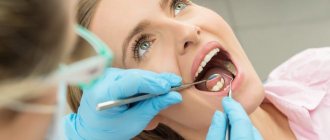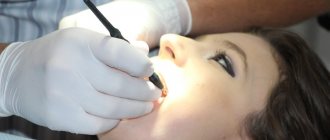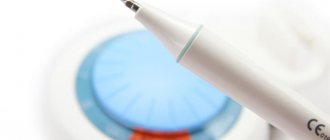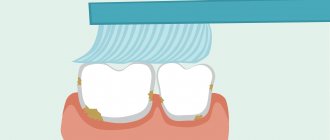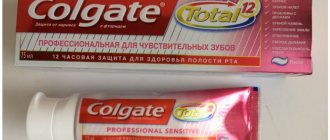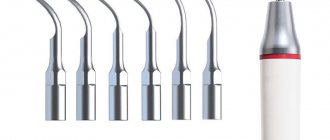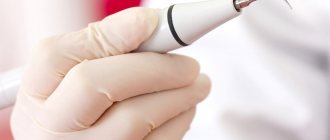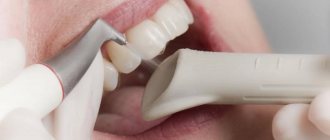Professional teeth cleaning is the removal of tartar and plaque in a dental office using special equipment.
Some consider this procedure useless and rely on high-quality oral care at home using modern toothbrushes. This is a misconception, and here's why.
Benefits of professional cleaning
Daily brushing of teeth has long become a ritual that is not always performed efficiently due to haste, sometimes due to basic laziness. Even with the most thorough cleaning with a good toothbrush, only 60% of plaque is removed, the remaining 40% is plaque on the back of the teeth, in the subgingival space and in the spaces between the teeth. Gradually, this plaque hardens, turning into tartar, which cannot be removed at home.
Dental plaque causes bad breath, caries, inflammation and bleeding gums. Long-term accumulation of microbes on dental plaque leads to the development of periodontitis - the roots of the teeth are exposed, the teeth become mobile, and begin to fall out. There is a risk of microbes penetrating from inflamed periodontal pockets into the blood, which provokes the emergence of secondary foci of infection in various organs: the heart, kidneys, joints, and thyroid gland.
Professional teeth cleaning is needed to:
- remove hard and soft dental deposits;
- prevent bleeding gums;
- eliminate bad breath;
- polish the enamel surface;
- prevent plaque adhesion;
- lighten the tooth surface;
- choose the right filling color for dental treatment;
- remove pigmented plaque after tea, coffee, “smoker’s plaque”;
- detect the initial stage of caries;
- avoid the occurrence of gingivitis and periodontitis;
- strengthen the enamel by treating it with fluoride gel.
Benefit
Contrary to popular belief, there is currently no evidence of the usefulness of occupational hygiene in preventing caries.
But professional cleaning is a good prevention of periodontitis. Moreover, for gingivitis and mild forms of periodontitis, it may be the only treatment method. By eliminating tartar, inflammation of the marginal gums is relieved - thus the periodontal condition is normalized, and other methods of treatment are not required.
Removing supragingival dark pigmented plaque improves appearance. Sometimes even professional hygiene is confused with bleaching. When whitening, the structure of tooth tissue changes chemically; when brushing, it only removes plaque adhering to the surface (the color of the teeth itself does not change, but visually they look lighter than with dark plaque).
Causes of plaque and tartar
The formation of dental plaque occurs unnoticed. First, it is a thin film consisting of bacteria and their metabolic products. Poorly cleaned food remains serve as a breeding ground for microorganisms. Over time, the film becomes denser, an acidic environment is formed under it, and this contributes to the destruction of enamel and the occurrence of caries. Tea, coffee and tobacco cause the plaque to become dark in color.
Gradually, plaque mineralizes, that is, hardens, turning into plaque and then into tartar. Its color is yellowish, but you can find stones of brown, black, and red color. Coloring depends on the level of oral hygiene, nutrition, and bad habits.
The causes of tartar formation include:
- improper brushing technique;
- unsuitable toothpaste or brush;
- smoking;
- insufficient chewing of food;
- uneven teeth;
- chewing on one side;
- presence of braces, bridges, crowns;
- deviations in the functioning of the endocrine system.
Depending on the location, tartar can be subgingival or supragingival. When located subgingivally, the stone is brown or black in color; it cannot be detected independently; this can only be done by a specialist using a dental probe. Typically, stones of this type are found in older people.
Supragingival stones are easy to see without any devices: they are yellow or white deposits, most often found on the front teeth.
It is impossible to remove dense plaque and tartar on your own using normal hygiene procedures.
Dental and oral hygiene in dentistry: why is it so important to undergo the procedure regularly?
The main task of oral hygiene is to remove hard and soft plaque from the surfaces of the teeth, as well as other areas and areas of the mouth.
Regular and timely removal of dental plaque will be the best prevention of caries and other dental diseases. In addition, oral hygiene in dentistry contributes to:
- Formation of healthy strong teeth;
- Complete destruction of harmful microorganisms that live in large numbers in the human oral cavity;
- Prevention of periodontal and gastrointestinal diseases.
Professional dental and oral hygiene helps keep your teeth enamel in excellent condition - after brushing, your teeth become whiter and your smile looks attractive! Professional oral hygiene is especially recommended for people with bad habits: smokers, patients who abuse strong tea and coffee. The procedure is also indicated for people with poor immunity, because often malfunctions in the body’s immune system are expressed precisely in the appearance of caries and inflammation in the oral cavity.
Regular dental hygiene will ultimately result in significant savings on dental treatment costs.
Which is inevitable if the teeth are not properly cared for and are covered with a thick layer of plaque. So, professional oral hygiene is certainly not a waste of time and money; on the contrary, it is a valuable investment in your own health!
Technique for professional teeth cleaning
The professional cleaning procedure lasts 1-1.5 hours and consists of the following steps:
- Preparation. The dentist determines the presence of tartar, caries, gum pathology and the degree of their development. If necessary, additional studies are carried out and tests are taken.
- Removal of dental stones. It is carried out using a dental device - an ultrasonic scaler. Ultrasound is capable of destroying tartar, while enamel is not affected by it. Stone removal occurs with the simultaneous supply of water pressure, which washes away destroyed particles and cools the teeth. The procedure is painless, but some patients feel discomfort during it, so local anesthesia using a gel or spray may be used. Tartar is also removed using laser systems. The method is based on the property of a laser to evaporate liquid. Tartar contains much more of it than enamel, so the laser destroys deposits layer by layer, evaporating moisture from them. During cleaning there is no contact between the instrument and tissues, which ensures a painless and sterile procedure. The laser has a bactericidal effect on pathogenic bacteria in the oral cavity and improves the absorption of medicinal substances by tooth enamel.
- Removing plaque, plaque and roughness after removing tartar. At this stage, the Air Flow air-abrasive system is used. Using water and baking soda, which are applied to the teeth under high pressure, all irregularities in the enamel are polished.
- Polishing the surface of the teeth. It is performed using an abrasive paste selected individually for each patient. The paste cares for fillings, makes the enamel surface perfectly smooth, which prevents the appearance of plaque.
- Application of fluoride-containing gel to the enamel. It envelops the teeth and protects them from increased sensitivity, strengthens tooth enamel. The gel lasts on the tooth surface from one to seven days.
The procedure for professional teeth cleaning should be done twice a year; the scope of work is determined by the doctor after an examination. By regularly visiting the dentist, you can avoid the formation of tartar, then cleaning will begin from the third stage.
The effectiveness of cleaning can be monitored using plaque indicators - special mouthwashes or chewable tablets that color plaque pink, blue or purple. The indicator is used before the cleaning procedure to assess the scale of upcoming work and identify plaque in hard-to-reach places; it is then applied to the teeth after brushing to see the results.
How to care for your teeth and oral cavity after a professional dental hygiene procedure?
Of course, you should also carry out dental and oral hygiene at home. Your doctor will tell you in detail how to do this correctly; he will also help you choose the right care products: paste, brush, and may recommend the use of additional tools - dental floss, brushes, irrigators.
General rules for dental and oral hygiene at home will be as follows:
1. Choose brushes of the correct degree of hardness for brushing your teeth and, best of all, with synthetic bristles;
2. To maintain high-quality oral hygiene, it will be useful to change the brush at least once every three months;
3. Teeth need to be brushed twice a day: in the morning and immediately before bed;
4. During oral hygiene procedures, it is imperative to brush not only your teeth, but also your gums and tongue. These measures will prevent the active accumulation of plaque and act as an excellent prophylaxis against periodontal diseases;
5. Don’t forget that you need to clean not only the surfaces of your teeth on both sides, but also the spaces between your teeth. To do this, it is recommended to use dental floss or special brushes.
Home oral and dental hygiene is not enough to completely remove plaque and tartar and monitor the appearance of caries, and therefore you need to visit the dentist 1-2 times a year and undergo a professional examination!
Teeth cleaning for periodontitis
Periodontitis is also characterized by inflammation of the gums and the presence of dental plaque, which if left untreated can lead to tooth loss. Therefore, professional cleaning is a prerequisite for treating the disease. Removal of plaque and tartar is carried out using ultrasound and hand instruments; The procedure is often painful and therefore requires local anesthesia. After removing plaque, bleeding and swelling of the gums may increase, so it is important to use antiseptic solutions for rinsing to prevent infection of the gums.
Harm
- Subgingival calculus removal can be a painful procedure, especially if the patient has severe plaque buildup. However, in the conditions of modern medicine, this issue is resolved by the use of anesthesia. In 98% of cases, the procedure takes place without anesthesia, and only in 2% of cases, with hypersensitivity to pain, anesthesia is used.
- During the procedure for removing tartar, damage to the gums occurs. This is an inevitable injury that is usually accompanied by bleeding and sometimes pain. These symptoms disappear within a few hours, and complete restoration of gum tissue occurs within a week.
- Professional ultrasonic teeth cleaning can cause fillings to fall out. However, the loss of the restoration indicates poor quality of its adhesion to the tooth. A timely detected defect in the seal-tooth seal prevents the development of hidden pathological processes. A filling that fits well to a tooth cannot be removed with ultrasound.
- Professional teeth cleaning with ultrasound has a number of contraindications. These include severe diseases of the cardiovascular system, as well as bronchitis and asthma, serious infectious diseases (hepatitis and tuberculosis), wearing a pacemaker, the presence of implants or orthopedic structures in the mouth, childhood and adolescence. In all cases where ultrasound cannot be used, an alternative is used - Air Flow abrasive cleaning.
To avoid or minimize the negative consequences of professional teeth cleaning, be sure to choose professionals with a proven reputation!
Make an appointment for an examination and consultation with the dentists at the VOKA clinic before the procedure.
Cleaning children's teeth
Professional cleaning is contraindicated for children, but their teeth also need care. Children do not know how to brush their teeth properly, so they often develop plaque on their enamel, which leads to caries or gum inflammation. Therefore, in childhood, you need to have your teeth cleaned by a dentist, who will clean each tooth separately using special brushes and pastes. After cleaning, the enamel is covered with a fluoride-containing gel, just like in adults.
Recommendations after professional teeth cleaning In addition to normal daily oral care, after professional teeth cleaning it is recommended:
- For 24 hours after the procedure, do not eat foods that have a coloring effect: beets, blueberries, cherries, mulberries, blue grapes, tomato sauces.
- Do not smoke, drink coffee or black tea for 24 hours.
- Brush your teeth or rinse your mouth with clean water after every meal.
- Use a soft-bristled toothbrush for several days.
- Choose a toothpaste that prevents the formation of deposits on tooth enamel.
Price for professional dental and oral hygiene in dentistry
To find out the exact price of professional dental and oral hygiene services, you will need to come to the clinic and undergo an examination by a dentist. This is important because the type of teeth cleaning will be determined based on your individual characteristics. Perhaps you have contraindications for some type of cleaning, or in your case a certain technology will work optimally.
If you want to find out the maximum useful details not only about the cost of a professional oral hygiene procedure, but also about the stages of its implementation, the doctors of our dentistry in Moscow “Firadent” will be happy to help you!
You can get a detailed free consultation from our specialists at any time convenient for you: just contact us by phone number and make an appointment!
"Firadent" - we will help make your teeth healthy and your smile bright and attractive!
Bleeding gums after professional cleaning
Sometimes you can come across complaints from patients that after cleaning their teeth from tartar, bleeding gums appeared. The reason is not the cleaning procedure itself, but the lack of qualifications of doctors. Therefore, you need to trust your health to professionals: find a good clinic where competent dentists will do everything right and avoid complications.
The financial costs of professional teeth cleaning are much less than the treatment of caries, which can be hidden under plaque, and its complications; Regular teeth cleaning by a specialist will help maintain your health, which means saving time and money.
Contraindications to the procedure
Like any medical procedure, teeth cleaning in a dental clinic has a number of limitations:
- increased sensitivity;
- the presence of erosion processes on the enamel;
- inflammation of the oral mucosa;
- history of arrhythmia;
- epilepsy;
- acute infectious diseases;
- diabetes;
- bronchial asthma, occurring in severe form;
- chronic rhinitis (including runny nose due to ARVI).
Ultrasound and Air Flow services are available to patients over 14 years of age.
